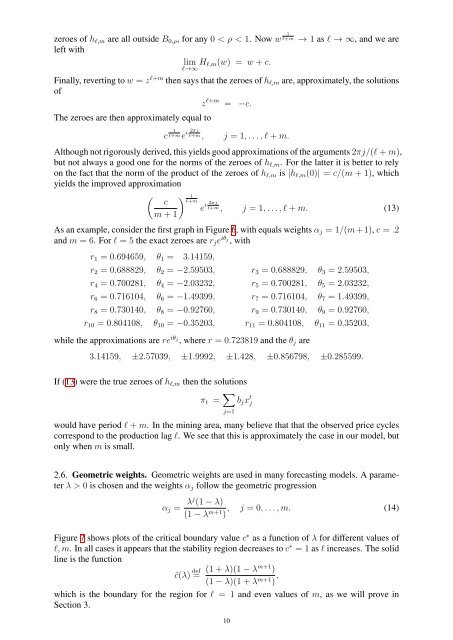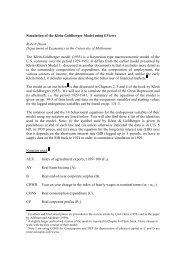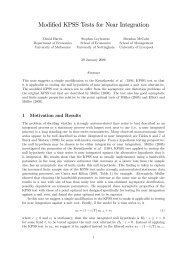Cobweb Theorems with production lags and price forecasting
Cobweb Theorems with production lags and price forecasting
Cobweb Theorems with production lags and price forecasting
Create successful ePaper yourself
Turn your PDF publications into a flip-book with our unique Google optimized e-Paper software.
zeroes of hℓ,m are all outside B0,ρ, for any 0 < ρ < 1. Now w 1<br />
ℓ+m → 1 as ℓ → ∞, <strong>and</strong> we are<br />
left <strong>with</strong><br />
lim<br />
ℓ→∞ Hℓ,m(w) = w + c.<br />
Finally, reverting to w = z ℓ+m then says that the zeroes of hℓ,m are, approximately, the solutions<br />
of<br />
z ℓ+m = −c.<br />
The zeroes are then approximately equal to<br />
c 1 2πj<br />
i ℓ+m e ℓ+m , j = 1, . . . , ℓ + m.<br />
Although not rigorously derived, this yields good approximations of the arguments 2πj/(ℓ + m),<br />
but not always a good one for the norms of the zeroes of hℓ,m. For the latter it is better to rely<br />
on the fact that the norm of the product of the zeroes of hℓ,m is |hℓ,m(0)| = c/(m + 1), which<br />
yields the improved approximation<br />
� c<br />
m + 1<br />
� 1<br />
ℓ+m 2πj<br />
i<br />
e ℓ+m , j = 1, . . . , ℓ + m. (13)<br />
As an example, consider the first graph in Figure 6, <strong>with</strong> equals weights αj = 1/(m+1), c = .2<br />
<strong>and</strong> m = 6. For ℓ = 5 the exact zeroes are rje iθj , <strong>with</strong><br />
r1 = 0.694659, θ1 = 3.14159,<br />
r2 = 0.688829, θ2 = −2.59503, r3 = 0.688829, θ3 = 2.59503,<br />
r4 = 0.700281, θ4 = −2.03232, r5 = 0.700281, θ5 = 2.03232,<br />
r6 = 0.716104, θ6 = −1.49399, r7 = 0.716104, θ7 = 1.49399,<br />
r8 = 0.730140, θ8 = −0.92760, r9 = 0.730140, θ9 = 0.92760,<br />
r10 = 0.804108, θ10 = −0.35203, r11 = 0.804108, θ11 = 0.35203,<br />
while the approximations are re iθj , where r = 0.723819 <strong>and</strong> the θj are<br />
3.14159, ±2.57039, ±1.9992, ±1.428, ±0.856798, ±0.285599.<br />
If (13) were the true zeroes of hℓ,m then the solutions<br />
πt = �<br />
j=1<br />
would have period ℓ + m. In the mining area, many believe that that the observed <strong>price</strong> cycles<br />
correspond to the <strong>production</strong> lag ℓ. We see that this is approximately the case in our model, but<br />
only when m is small.<br />
2.6. Geometric weights. Geometric weights are used in many <strong>forecasting</strong> models. A parameter<br />
λ > 0 is chosen <strong>and</strong> the weights αj follow the geometric progression<br />
bjx t j<br />
αj = λj (1 − λ)<br />
(1 − λm+1 , j = 0, . . . , m. (14)<br />
)<br />
Figure 7 shows plots of the critical boundary value c ∗ as a function of λ for different values of<br />
ℓ, m. In all cases it appears that the stability region decreases to c ∗ = 1 as ℓ increases. The solid<br />
line is the function<br />
˜c(λ) def<br />
= (1 + λ)(1 − λm+1 )<br />
(1 − λ)(1 + λ m+1 ) ,<br />
which is the boundary for the region for ℓ = 1 <strong>and</strong> even values of m, as we will prove in<br />
Section 3.<br />
10







